From the first launch of Space Shuttle Columbia on April 12, 1981 (Mission STS-1) through the final launch of Space Shuttle Atlantis on July 8, 2011 (Mission STS-135), many incredible photos were taken. This gallery presents some of the most spectacular launch images of space shuttles Columbia, Challenger, Discovery, Atlantis, and Endeavour.
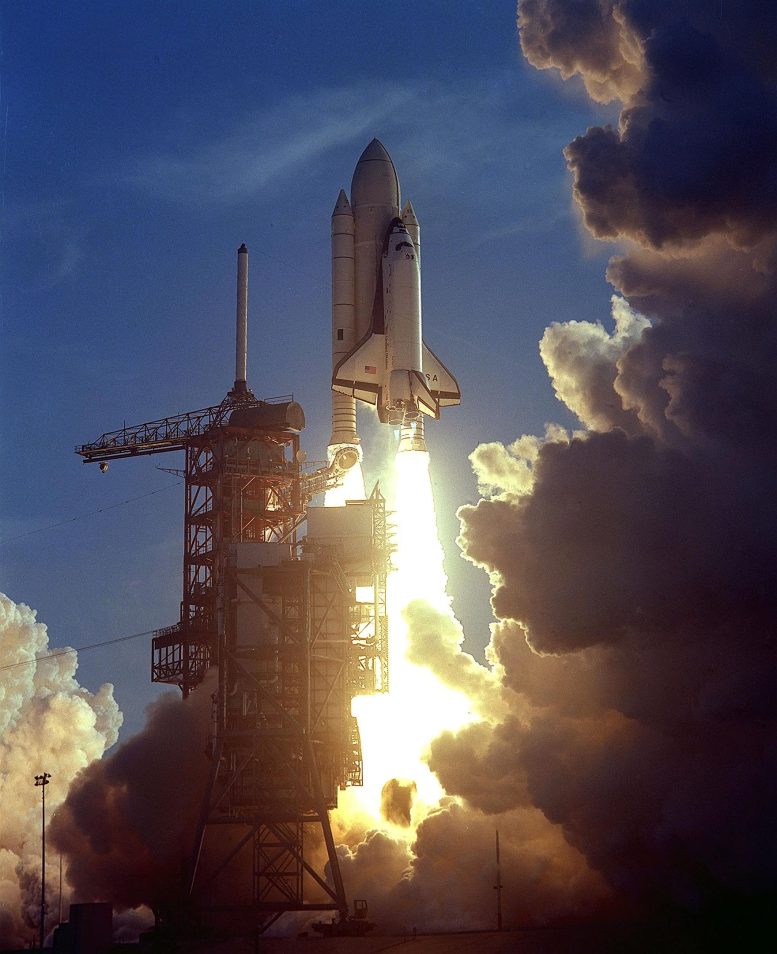
A new era in space flight began on April 12, 1981, when the first shuttle mission soared into orbit from NASA’s Kennedy Space Center in Florida. STS-1 commander John Young had already flown in space four times, including a walk on the moon in 1972. Bob Crippen, the pilot, was a Navy test pilot who would go on to command three future shuttle missions. But nothing either man had done or would do was quite like this. The shuttle was humankind’s first re-usable spacecraft. The orbiter, which many people think of as the “shuttle,” would launch like a rocket and land like a plane. The two solid rocket boosters that helped push them into space would also be re-used, after being recovered in the ocean. Only the massive external fuel tank would burn up as it fell back to Earth. It was all known as the Space Transportation System. On a long list of firsts, one stunning fact stands out: it was the first time in history a new spacecraft was launched on its maiden voyage with a crew aboard. Credit: NASA
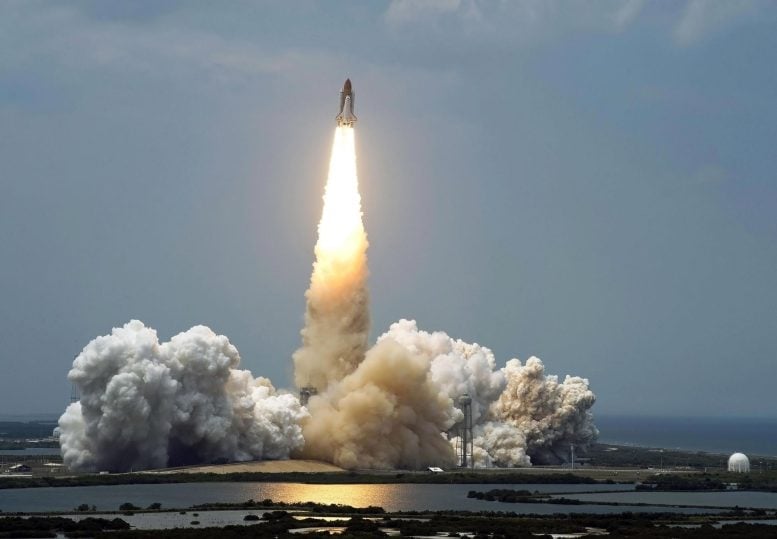
From Launch Pad 39A at NASA’s Kennedy Space Center in Florida, space shuttle Atlantis roars into the sky on a column of fire on the STS-125 mission to service NASA’s Hubble Space Telescope. Liftoff was on time at 2:01 p.m. EDT on May 11, 2009. Credit: Photo courtesy of Scott Andrews
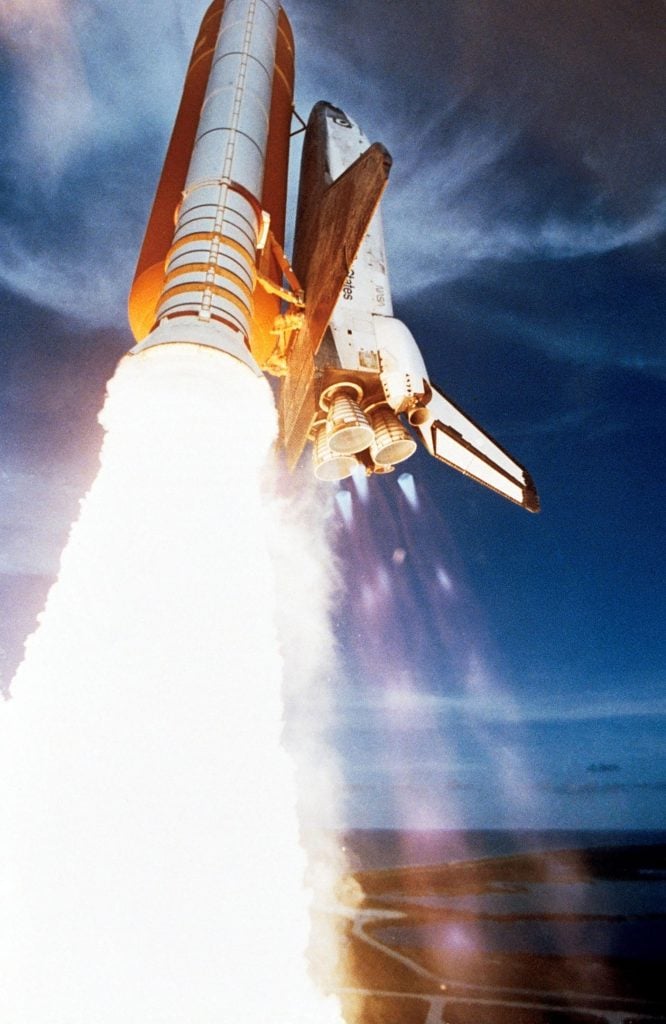
Challenger jumps off the launch pad in 1985 to begin a successful mission. The main purpose of this mission was to test a new space based laboratory named Spacelab 2. Spacelab 2 takes advantage of the effectively weightless conditions in orbit to carry out experiments in areas such as astronomy, physics, life science, materials science, and atmospheric physics. Challenger and her crew were lost in 1986 when a booster failure resulted in the breakup of the vehicle. Previously, Challenger and her crews flew nine successful Space Shuttle missions and made significant contributions to America’s scientific growth. Credit: NASA
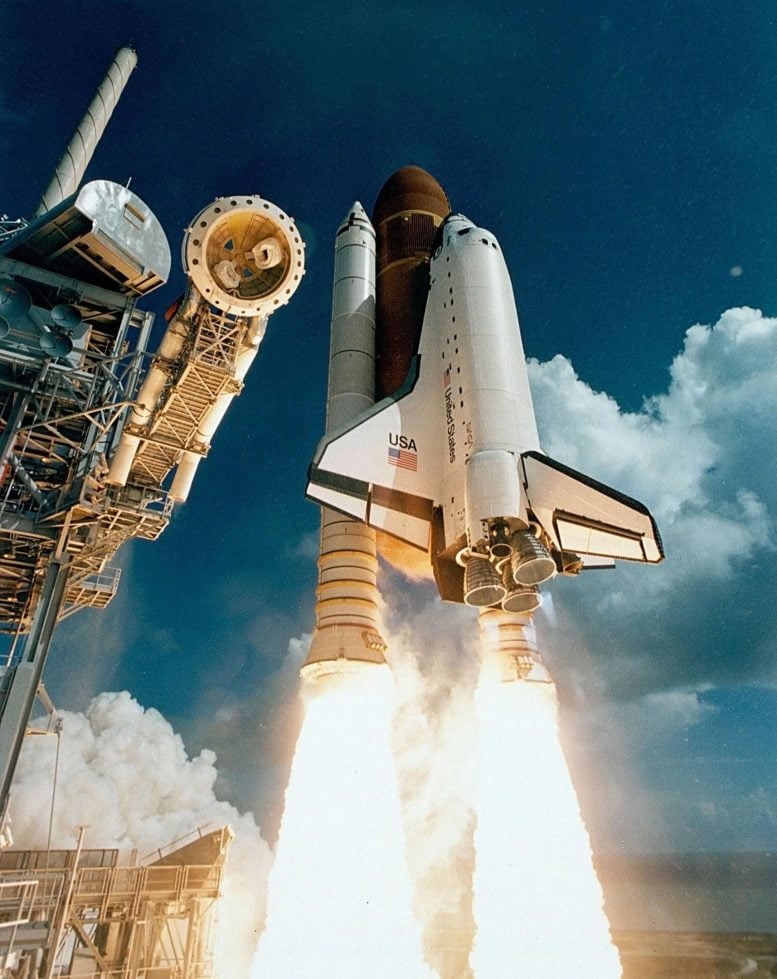
Space shuttle Atlantis, OV-104, was delivered to NASA’s Kennedy Space Center in Florida, in April of 1985. Mission STS-51J was the first flight of space shuttle Atlantis, launching October 3, 1985 to deliver a communications satellite for the Department of Defense. Studies also were conducted by the crew on space motion sickness, cardiovascular deconditioning, muscle loss, changes in coordination, balance strategies, and changes in the body’s biochemistry. Atlantis landed at Edwards Air Force Base in Calif. on October 7, 1985 after a successful 4-day mission. Credit: NASA/KSC
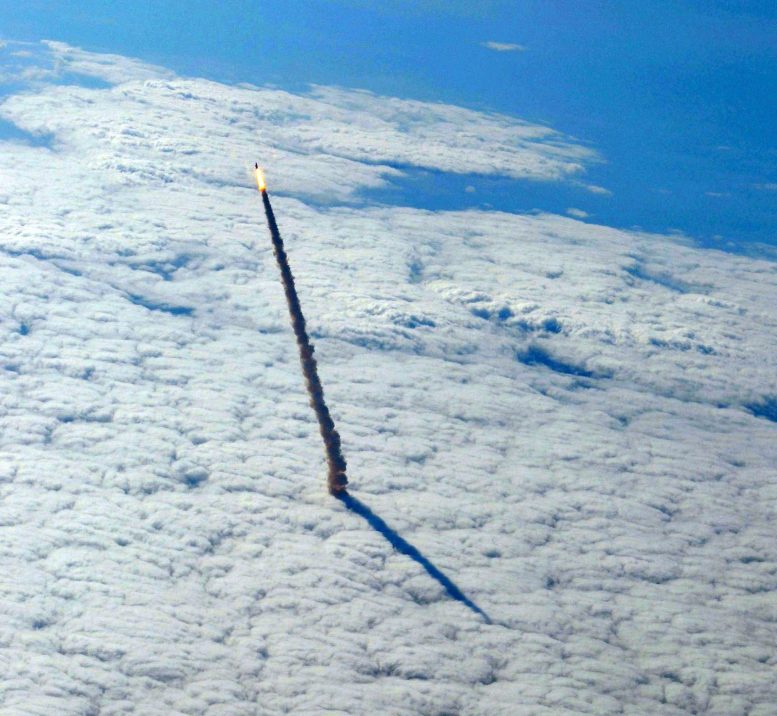
Photographed from a shuttle training aircraft, space shuttle Endeavour and its six-member STS-134 crew head toward Earth orbit and rendezvous with the International Space Station. Liftoff was at 8:56 a.m. (EDT) on May 16, 2011, from Launch Pad 39A at NASA’s Kennedy Space Center. Onboard are NASA astronauts Mark Kelly, commander; Greg H. Johnson, pilot; Michael Fincke, Andrew Feustel, Greg Chamitoff and European Space Agency astronaut Roberto Vittori, all mission specialists. STS-134 will deliver the Alpha Magnetic Spectrometer-2 (AMS), Express Logistics Carrier-3, a high-pressure gas tank and additional spare parts for the Dextre robotic helper to the International Space Station. STS-134 is the final spaceflight for Endeavour. Credit: NASA
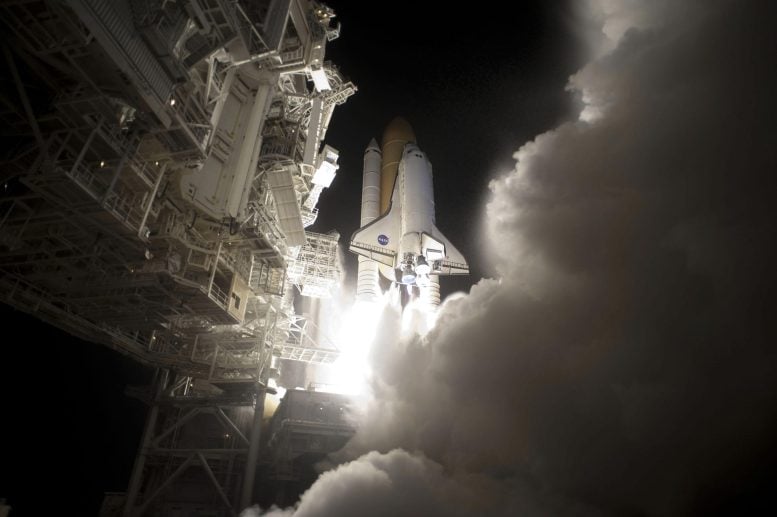
An exhaust cloud billowed around Launch Pad 39A at NASA’s Kennedy Space Center in Florida as space shuttle Discovery lifted off to begin the STS-131 mission. The seven-member crew will deliver the multi-purpose logistics module Leonardo, filled with supplies, a new crew sleeping quarters and science racks that will be transferred to the International Space Station’s laboratories. The crew also will switch out a gyroscope on the station’s truss, install a spare ammonia storage tank and retrieve a Japanese experiment from the station’s exterior. Credit: NASA/Tony Gray and Tom Farrar
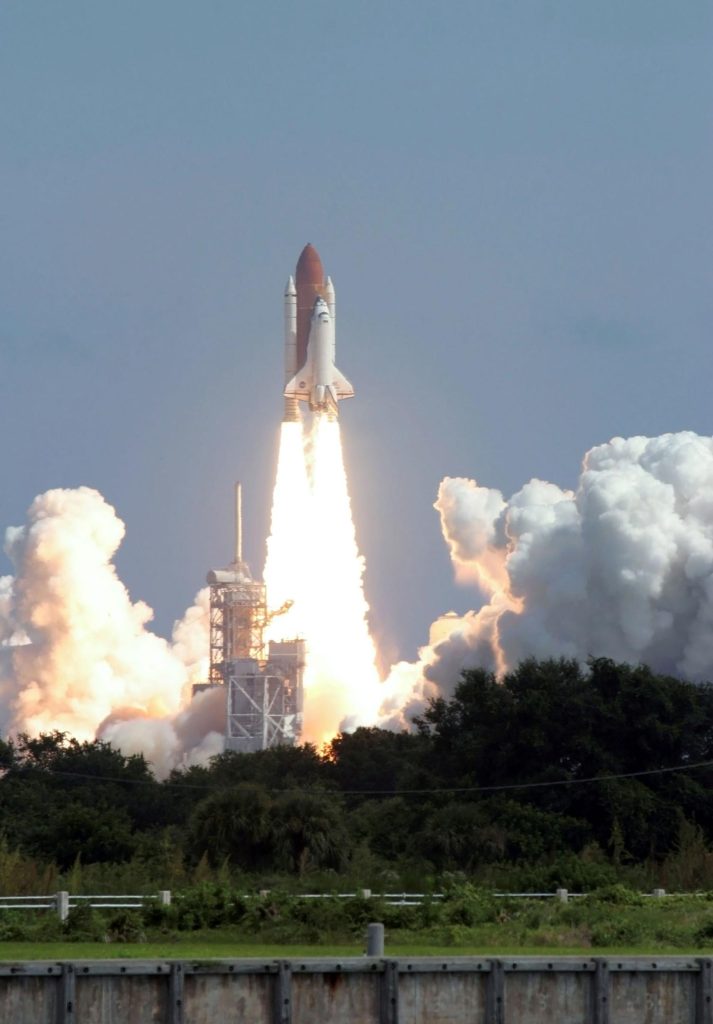
With a fiery liftoff, Space Shuttle Atlantis roars off the launch pad for a rendezvous with the International Space Station on mission STS-115. After launch attempts were scrubbed Aug. 27 and 29 and Sept. 3 and 8 due to weather and technical concerns, this launch was executed perfectly. During the STS-115 mission, Atlantis’ astronauts will deliver and install the 17.5-ton, bus-sized P3/P4 integrated truss segment on the station. The girder-like truss includes a set of giant solar arrays, batteries and associated electronics and will provide one-fourth of the total power-generation capability for the completed station. STS-115 is scheduled to last 11 days. Credit: NASA/Dennis Sabo
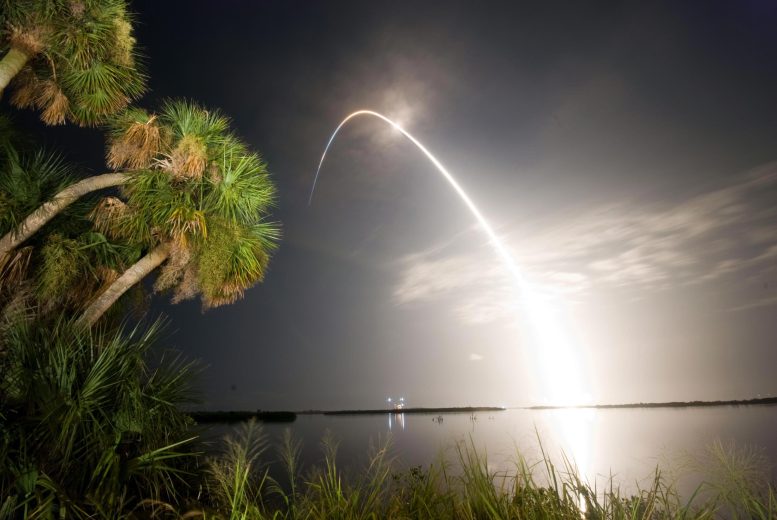
Viewed from the Banana River Viewing Site at NASA’s Kennedy Space Center in Florida, space shuttle Discovery arcs through a cloud-brushed sky, lighted by the trail of fire after launch on the STS-128 mission. Liftoff from Launch Pad 39A was on time at 11:59 p.m. EDT. The first launch attempt on Aug. 24 was postponed due to unfavorable weather conditions. The second attempt on Aug. 25 also was postponed due to an issue with a valve in space shuttle Discovery’s main propulsion system. The STS-128 mission is the 30th International Space Station assembly flight and the 128th space shuttle flight. The 13-day mission will deliver more than 7 tons of supplies, science racks and equipment, as well as additional environmental hardware to sustain six crew members on the International Space Station. The equipment includes a freezer to store research samples, a new sleeping compartment and the COLBERT treadmill. Credit: NASA/Ben Cooper
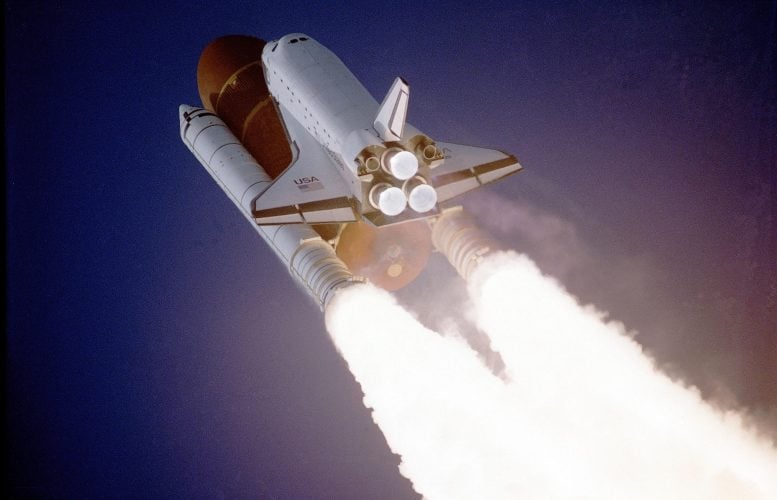
Space Shuttle Atlantis takes flight on the STS-27 mission in December 2, 1988. The Shuttle takes about 8.5 minutes to accelerate a speed of over 17,000 and go into orbit. Credit: NASA
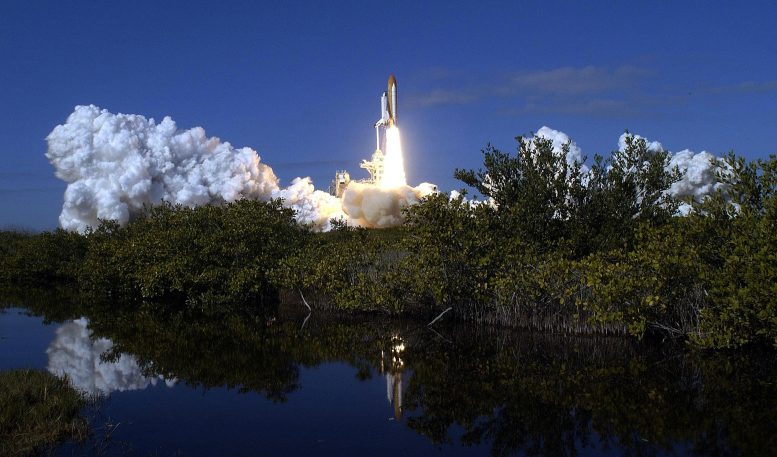
As billows of smoke and steam roll across the landscape, the launch of space shuttle Columbia on mission STS-107 is reflected in nearby water. Following a flawless and uneventful countdown, liftoff occurred at 10:39 a.m. EST on January 16, 2003. The 16-day research mission was the 28th flight of the orbiter Columbia and the 113th flight overall in NASA’s Space Shuttle Program. Columbia and the STS-107 crew were lost over east Texas during the landing descent to Kennedy Space Center on February 1, 2003, approximately 16 minutes before landing. Credit: Courtesy of Scott Andrews
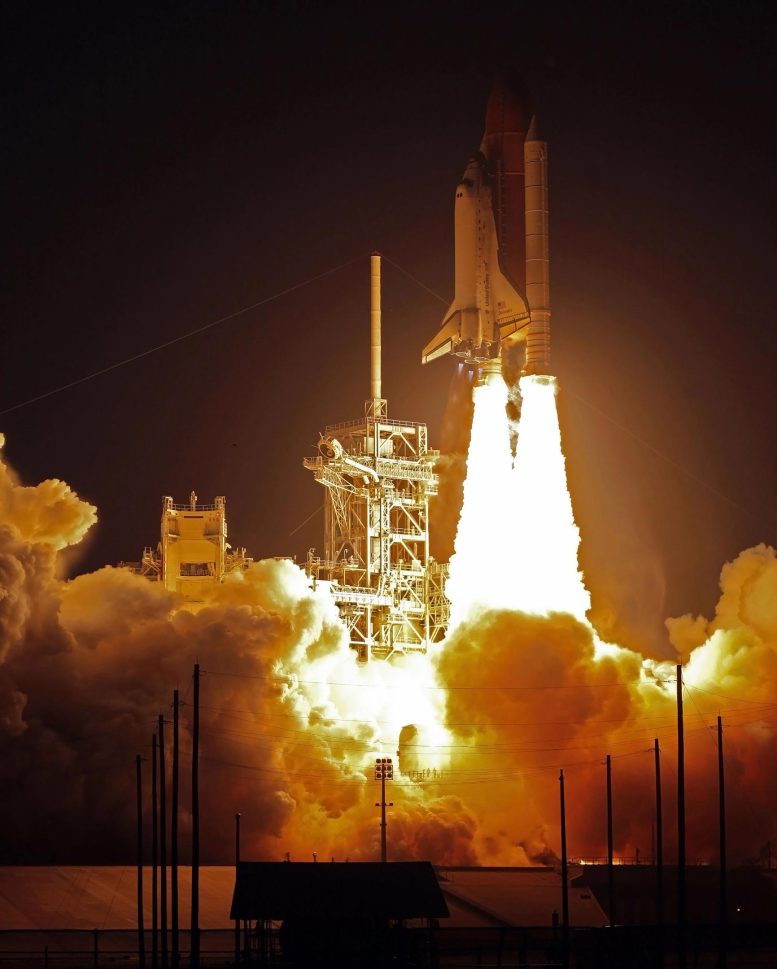
Space shuttle Discovery lit up the sky at sunset as it roared off Launch Pad 39A at NASA’s Kennedy Space Center on its mission to the International Space Station. The STS-119 mission is the 28th to the space station and Discovery’s 36th flight. Discovery will deliver the final pair of power-generating solar array wings and the S6 truss segment. Installation of S6 will enable the station to house a six-member crew. Credit: NASA
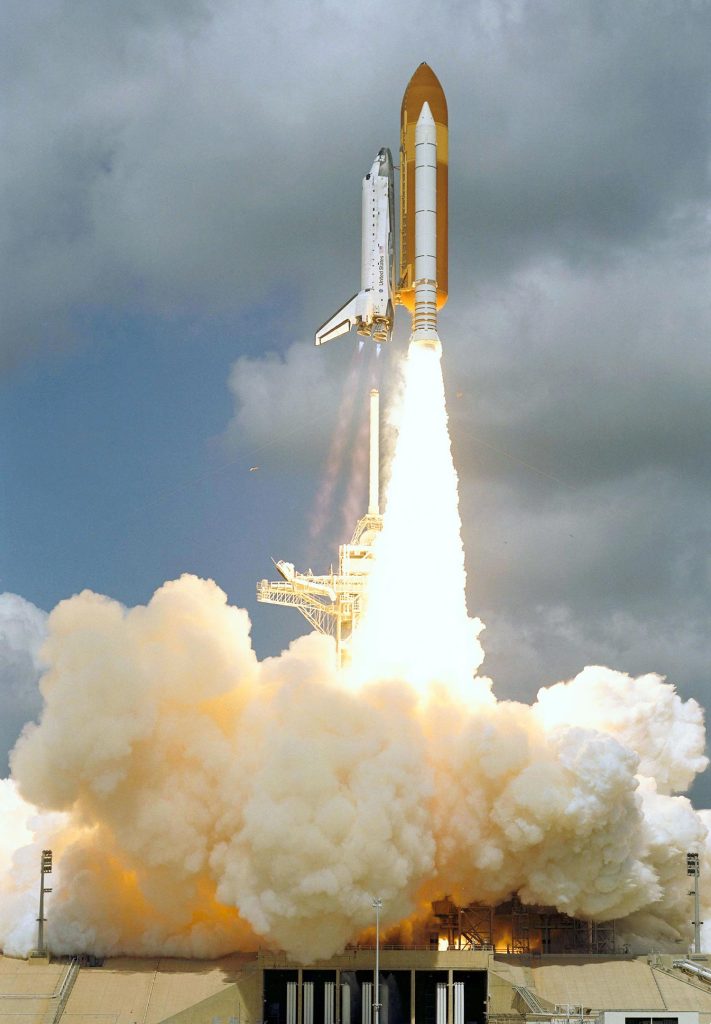
As billows of smoke and steam roll away, space shuttle Discovery leaps from Launch Pad 39B on the historic return to flight mission STS-114. This was the 114th space shuttle flight and the 31st for Discovery. On this mission to the International Space Station, the crew performed inspections on-orbit for the first time of all of the reinforced carbon-carbon panels on the leading edge of the wings and the thermal protection system tiles using the Canadian-built orbiter boom sensor system and the data from 176 impact and temperature sensors. Credit: NASA
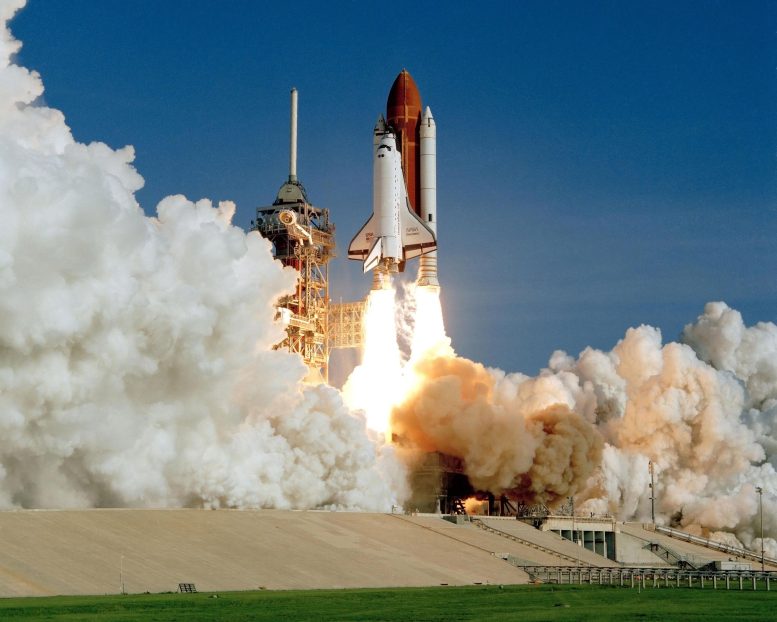
Space Shuttle Discovery soars away from Launch Pad 39A at the Kennedy Space Center, beginning its maiden voyage and a storied spaceflight career that spanned more than 26 years. The on-time liftoff occurred at 8:42 A.M. EDT on August 30, 1984. credit: NASA
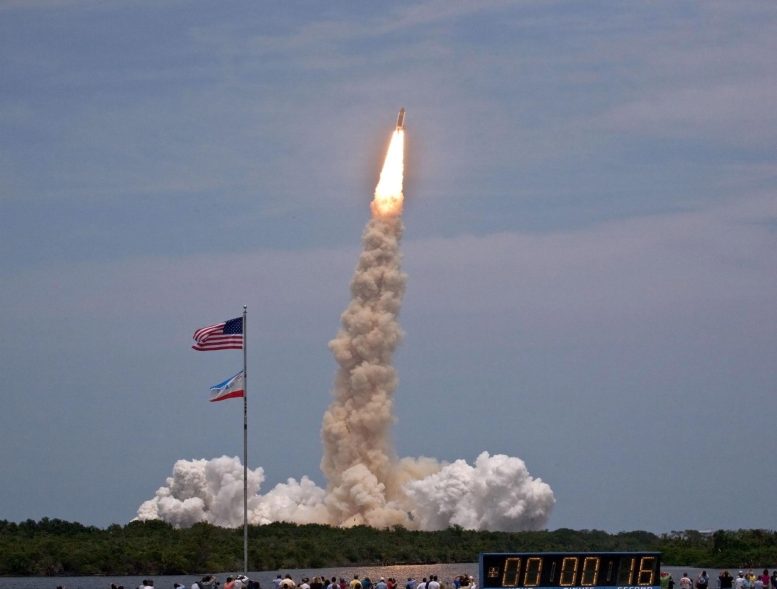
Under a dry, hot, cloud-washed Florida sky, space shuttle Atlantis roars off Launch Pad 39A at NASA’s Kennedy Space Center in Florida with its crew of seven for a rendezvous with NASA’s Hubble Space Telescope. The launch was on time at 2:01 p.m. EDT. Atlantis’ 11-day flight will include five spacewalks to refurbish and upgrade the telescope with state-of-the-art science instruments that will expand Hubble’s capabilities and extend its operational lifespan through at least 2014. The payload includes the Wide Field Camera 3, fine guidance sensor and the Cosmic Origins Spectrograph. Credit: NASA/Fletcher Hildreth
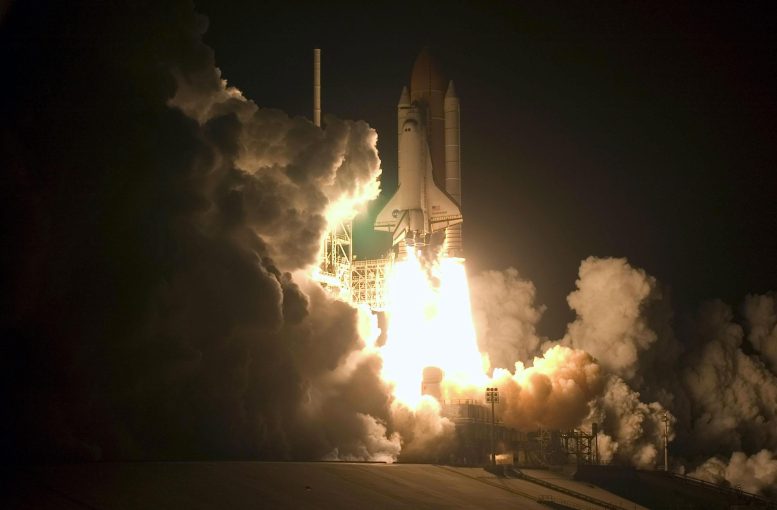
Light-filled clouds of smoke and steam roll across Launch Pad 39A at NASA’s Kennedy Space Center in Florida as space shuttle Endeavour hurtles into the night sky on the STS-126 mission on November 14, 2008. Credit: NASA/Rick Wetherington/Tim Powers
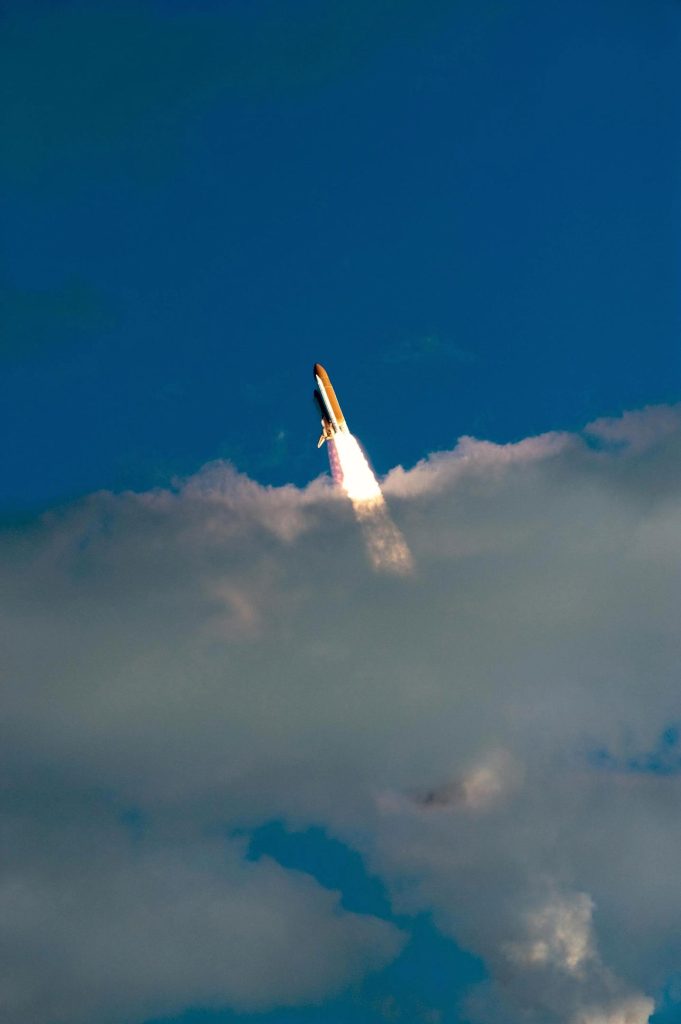
Space shuttle Atlantis emerges through the clouds over Launch Pad 39A on a balmy Florida afternoon at NASA’s Kennedy Space Center. Liftoff on its STS-129 mission came at 2:28 p.m. EST on Nov.ember16, 2009. Credit: NASA/Carl Winebarger
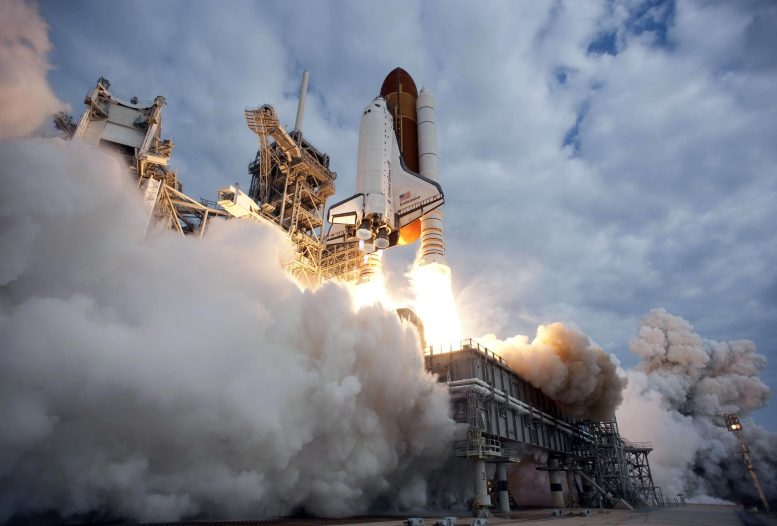
Space shuttle Endeavour rises on twin columns of flame from Launch Pad 39A at NASA’s Kennedy Space Center in Florida. Endeavour began its final flight, the STS-134 mission to the International Space Station, at 8:56 a.m. EDT on May 16, 2011. Credit: NASA/Tony Gray and Tom Farrar
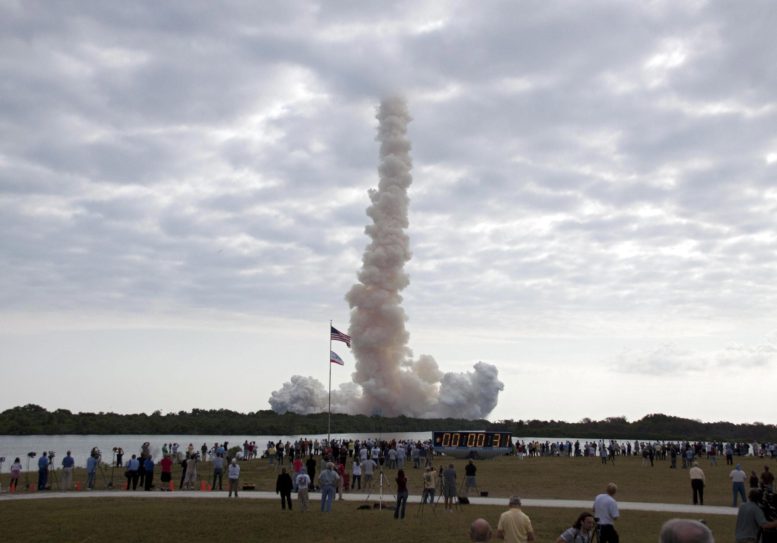
An exhaust cloud forms around Launch Pad 39A at NASA’s Kennedy Space Center in Florida as space shuttle Endeavour soars into the sky on the STS-134 mission to the International Space Station. The shuttle and its six-member crew lifted off from Launch Pad 39A at NASA’s Kennedy Space Center in Florida at 8:56 a.m. EDT on May 16. STS-134 will deliver the Alpha Magnetic Spectrometer-2 (AMS), Express Logistics Carrier-3, a high-pressure gas tank and additional spare parts for the Dextre robotic helper to the International Space Station. Credit: NASA/Troy Cryder
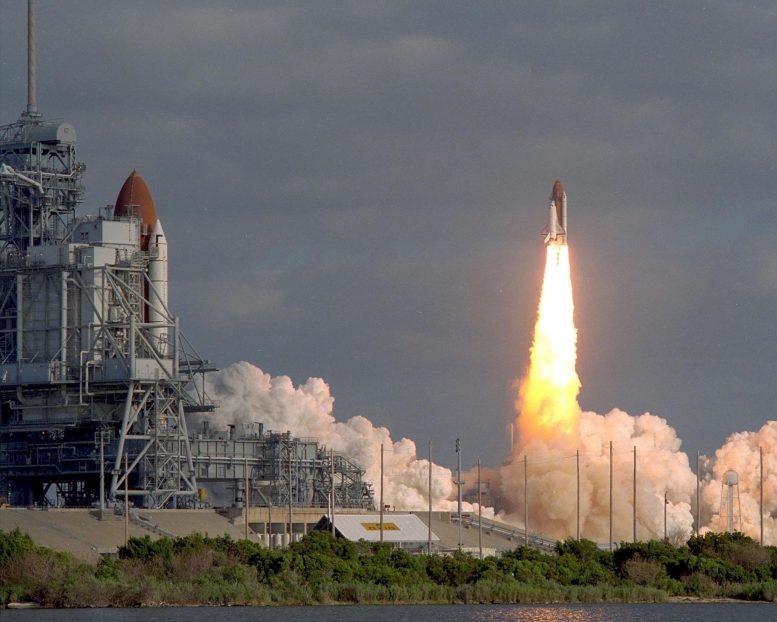
Space shuttle Columbia on Pad 39A “watches” the picture-perfect ascent of sister ship Discovery during its liftoff on STS-31. The launch pads are separated by 1.6 miles. Discovery, carrying a five-member crew and the Hubble Space Telescope, lifted off at 8:34 a.m. EDT on April 24, 1990. Credit: NASA
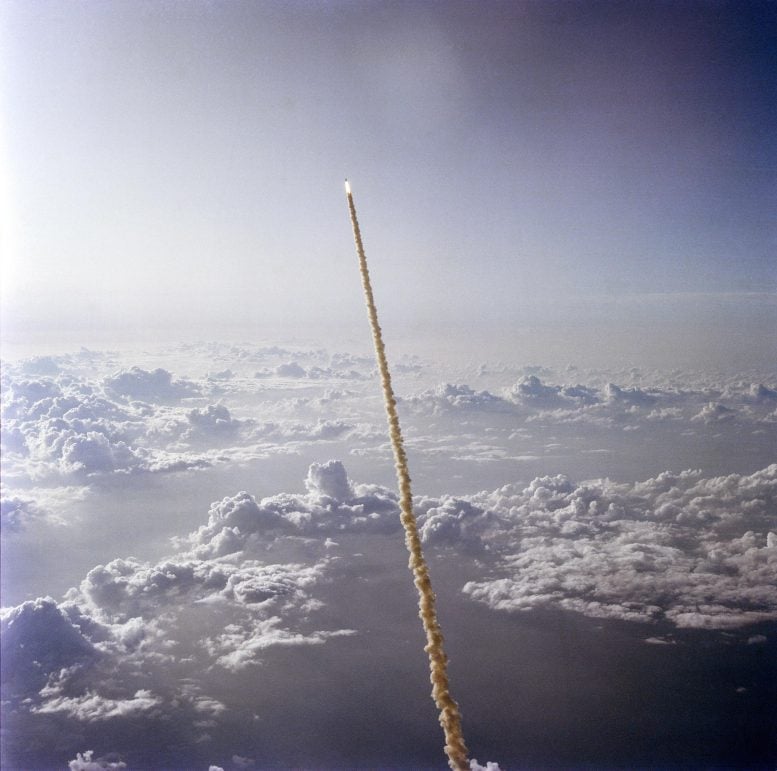
On June 18, 1983, Sally Ride became the first American woman to fly in space when the space shuttle Challenger launched on mission STS-7 from Pad 39A at NASA’s Kennedy Space Center in Florida. The STS-7 crew consisted of astronauts Robert Crippen, commander, the first two-time space shuttle astronaut; Frederick H. Hauck, pilot; and three mission specialists — Ride, John M. Fabian and Norman E. Thagard. This high-angle view of the shuttle liftoff, showing a lengthy stretch of Florida Atlantic coastline and a number of large cumulus clouds, was photographed with a handheld 70mm camera by astronaut John W. Young, who piloted the Shuttle Training Aircraft (STA) for weather monitoring at launch and landing sites for STS missions. One of Sally Ride’s jobs was to call out “Roll program” seven seconds after launch. “I’ll guarantee that those were the hardest words I ever had to get out of my mouth,” she said later. Credit: NASA
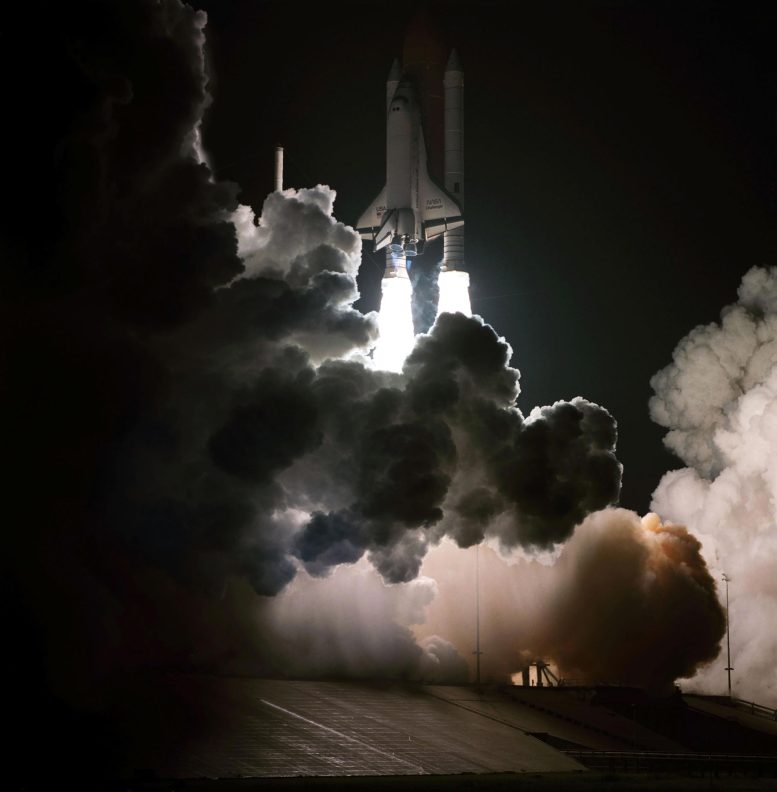
Space shuttle Challenger’s third flight was the first to have its beginnings in darkness, as NASA’s eighth space shuttle launch lit up the Florida sky at 2:32 a.m. EDT, August 30, 1983. The STS-8 crew consisted of Commander Richard Truly, pilot Daniel Brandenstein, and mission specialists Dale Gardner, Guy Bluford and William Thornton. On January 28, 1986, Challenger and its crew were lost when a booster engine failed, causing the shuttle to break apart just 73 seconds after launch. Credit: NASA
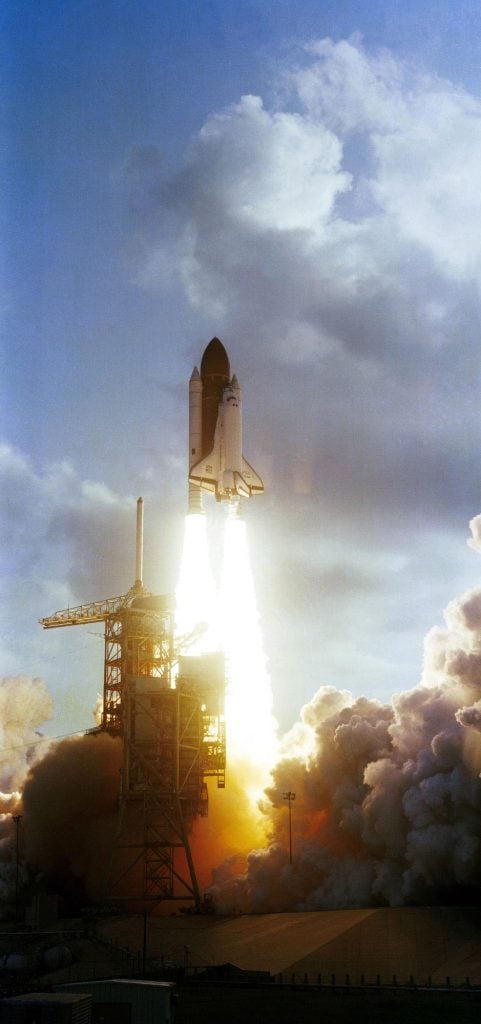
Sally Ride and her crewmates rocket into space aboard Space Shuttle Challenger at 7:33 a.m. EDT on June 18, 1983. Ride later described the launch as “exhilarating, terrifying and overwhelming all at the same time.” Credit: NASA
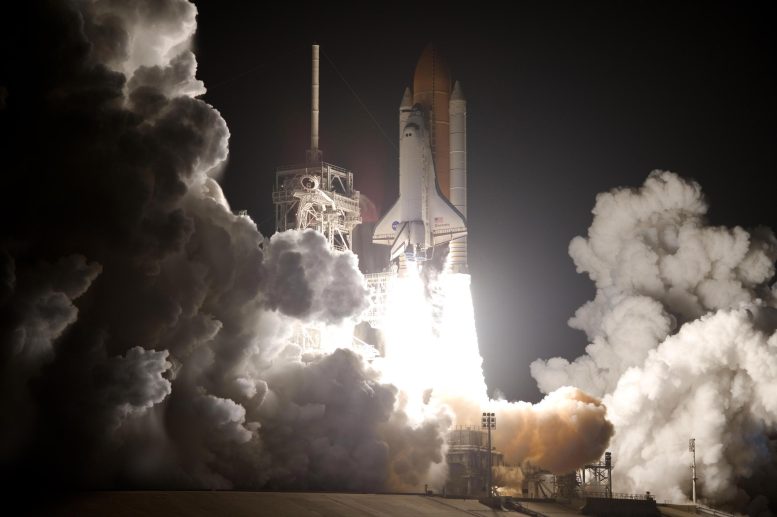
Billows of smoke and steam rise above Launch Pad 39A at NASA’s Kennedy Space Center in Florida alongside space shuttle Discovery as it races toward space on the STS-128 mission. The STS-128 mission is the 30th International Space Station assembly flight and the 128th space shuttle flight. The 13-day mission will deliver more than 7 tons of supplies, science racks and equipment, as well as additional environmental hardware to sustain six crew members on the International Space Station. The equipment includes a freezer to store research samples, a new sleeping compartment and the COLBERT treadmill. Credit: NASA/Sandra Joseph and Kevin O’Connell
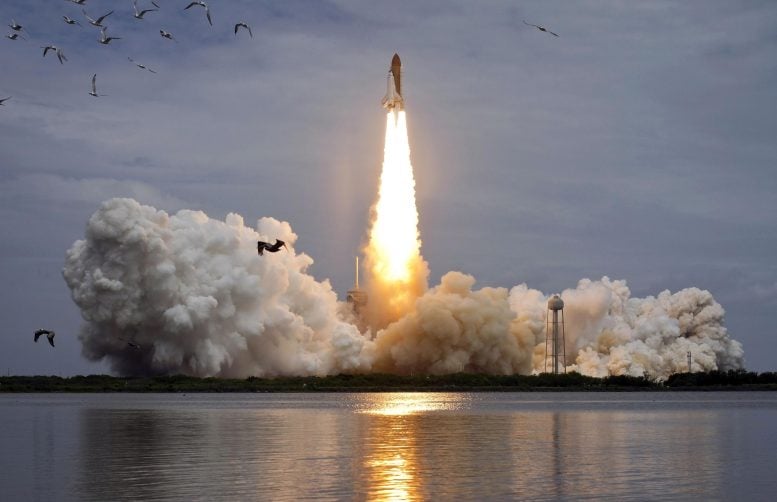
Space shuttle Atlantis is seen as it lifts off from NASA Kennedy Space Center’s Launch Pad 39A at 11:29 a.m. EDT, July 8, 2011. The launch of Atlantis on the STS-135 mission, is the final flight of the Shuttle Program. Credit: NASA/Bill Ingalls

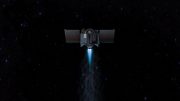
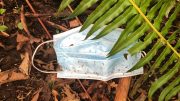





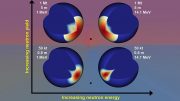
Be the first to comment on "24 Spectacular Space Shuttle Launch Images"